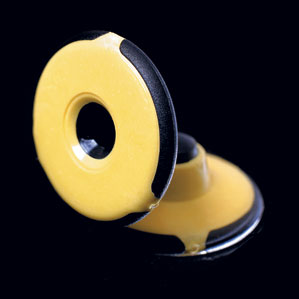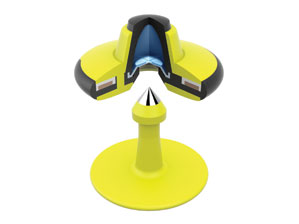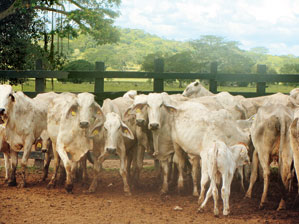
miguel boyayanElectronic earring with embedded chip will be exhibited at design fair in Europemiguel boyayan
Yellow plastic earrings equipped with an embedded microchip are embellishing the ears of thousands of bovines on various Brazilian cattle ranches. The objective is not aesthetic; the objective is to identify and store data on the animals. These electronic devices are the result of the technological development work conducted by Korth, a company located in the city of São Carlos, São Paulo State. Since October 2008, the company, also known in this industry as Animalltag, has participated in a pilot program to become the official supplier for the bovine and buffalo tracking program in Colombia, a bidding competition that involves 14 other companies, five of which are from Canada, two from the United States, two from France, one from Spain and four of which are mergers between Colombian companies and companies from other countries.
The bid, which is divided into two phases, is tough. The first phase, which eliminated all but four of the bidders, included an evaluation of the microchip’s performance, the resistance of the material and the technology developed by each company. The second phase comprises field ratification. Animalltag is initially supplying the electronic earrings to 30 cattle ranches in Colombia; it exports the product to Uruguay, Chile, Peru, Venezuela, Argentina, Panama and Paraguay. In November, the company achieved another goal. The earring design is among the 19 Brazilian designs granted the International Forum (IF) Product Design Award 2009, Europe’s most important design award. The award-winning designs will be exhibited at a show in Hanover, Germany, in 2009.
The company’s tracking system is comprised of two earrings – an electronic one and a visual one (with printed numbers), a pair of pliers and a microchip scanner which identifies and stores information on the animal, such as the weight, the medicines it takes, vaccines and pregnancy diagnosis; this information can then be downloaded into a computer. This information is important for the management of a cattle raising enterprise, both to check on the animal’s progress and to control diseases. Korth has gained significant market acceptance starting in 2004, when the company’s three partners – whose ages now range from 37 to 44 years, decided to develop their own system and stop importing similar solutions which were expensive for end consumers. The starting point was a project funded by FAPESP under the Programa Pesquisa Inovativa na Pequena e Micro Empresa/Pipe [funding program for small businesses]; the objective was to develop an earring equipped with an electronic device inside. The earring is equipped with an imported chip and a system with radio frequency identification/RFID technology, which emits and captures data through specific radio signals. The electronic set inside the earring, also referred to as a transponder, does not have a power source such as a battery to make it work. Instead, it is activated by the magnetic field in the portable scanning equipment, which resembles a radio equipped with a rod-shaped antenna.

korthBeige microchip inside the earring and blue area which holds the healing medication for the animal’s earkorth
One of the project’s innovations – object of one of three filed patent requests – is the inclusion of a healing substance in the device. The earring is comprised of two parts joined by the pliers and clipped to the animal’s ear. When the two parts of the earring are joined, a membrane inside the earring is torn and a healing substance is released to heal the injury to the ear. This measure avoids myiasis, a disease common to bovines, which is caused by fly larvae in rainy regions, especially after a hole is punched in the bovine’s ear. Another patent request is related to the encapsulation of the chip and the third patent request, filed together with the Empresa Brasileira de Pesquisa Agropecuária/ Embrapa, refers to a tracking system to monitor the displacements of the animals. Researchers from the Embrapa Pecuária Sudeste unit, located in São Carlos, are from the company which developed equipment that resembles the Sem Parar toll system used in toll booths on highways for trucks and for sanitary check points. “We developed a tag (transponder) that monitors the displacement of the animals from one ranch to another, for example. This tag identifies and registers, through the signs emitted from the earrings, the cattle being placed inside cattle trucks for transportation,” says mechanical engineer Carlos Gustavo Machado, one of the partners of Animalltag. At the sanitary check points, an electrical-magnetic scanner reads the information on the tag inside the truck and the supervising officer knows which animals are inside the truck, where they come from and where they’re going.
It is important to track the animals to know where each animal in the batch was, with whom and which other animals that animal had contact with. This keeps disease from spreading. “Knowing where animal number 1 was, for example, if it had been in contact with animals 2, 3 and 4, facilitates sanitary control in cases of foot-and-mouth disease, which incubates for a period of 8 days and can devastate a cattle herd,” explains Machado. Brazil has animal tracking standards for bovines – which total approximately 180 million head of cattle in the country – and buffaloes to identify the origin and identity of the animals. The standards are listed under the Serviço de Rastreabilidade da Cadeia Produtiva de Bovinos e Bubalinos/Sisbov animal tracking system, which is not mandatory for cattle ranchers, who can decide how to identify their cattle. In addition to the electronic earrings, buttons, tattoos and branding by number can be used to track the animals and, most of all, provide security for the overseas market. In Machado’s opinion, the value of a ton of meat nearly doubles in markets that require the existence of electronic tracking, as is the case of Uruguay, where Animalltag has a branch. “In Uruguay, the price of a ton of meat doubled after this system was implemented,” says.
In November, the Chamber of Deputies’ Commission for Justice and Citizenship approved a bill of law that will make it mandatory to adopt tracking measures by means of branding and tattooing. Those who defend these two older systems allege that they are easier to use by small ranchers. The price of the electronic system is still a barrier for many ranchers. “An electronic earring can cost less than R$ 4,00, depending on the quantity. If we consider that the price of the arroba (15 kilos) is currently R$ 80,00 and the animal is slaughtered when it weighing an average of 18 arrobas, at the price of R$ 1.440,00, then the cost is low,” says Machado. “An earring cannot be duplicated and it prevents failures in the system.” Tracking cattle is very tiring and subject to many mistakes when done without electronic equipment. Normally, the rancher uses a notepad to write down all the data, especially the weight, sanitary and reproduction conditions. “Mistakes are common, especially in regard to the weight, and even such erroneous comments as ‘bull and calf’ rather than ‘cow and calf’ are common occurrences,” he says.
To make things easier for cowhands and increase the use of technology by cattle ranchers, Animalltag created the “Tabela do Peão,” a kind of leather pad that carries several electronic cards representing tasks – such as weighing, insemination, vaccines – and the animal’s file information, with breed, gender and age. To register the animal or insert any information into the bull or cow’s electronic identification form, the cowhand brings the antenna close to the earring, allowing the system – and then the electronic form in the table – to identify the animal. The task or the data on the animal is automatically registered in the animal’s file inside the scanner’s memory. In some cases, it is necessary to click on the “yes” or “no” keys to complement the inserted information. The scanning is always conducted in a wooden corridor where the animal is confined for inspection at a given moment.

korthHerd of cattle in Colombia: electronic and traditional earrings with printed numberkorth
Automatic scales
Registration of the animal’s weight is another innovation developed by the company. “We developed an electronic scale (installed in the wooden corridor) which is totally integrated with the scanner. The cowhand only has to place the rod next to the card with the name ‘electronic weighing’; the system sends a command to the scales and the weight is automatically inserted into the animal’s electronic file,” Machado explains. The company decided to manufacture the earrings, the scanner and the scales, as well as the software that comes with the equipment. Korth’s plant facilities are located in São Carlos; the company employs 56 people, four of whom are product development engineers and three are software developers.
“Four of our Brazilian employees have been living in Colombia since October,” says Machado. This commercial operation has cost the company approximately US$ 500 thousand; this money was spent on the activation of the equipment, follow-up of the tests and local software development. “In addition to this sum, Korth’s investments in the period from 2005 to 2008, the new phase, totaled R$ 2 million and annual invoicing totals R$ 8.5 million,” says Machado. He acknowledges that the company’s rapid success would not have been possible without FAPESP’s investment of R$ 323 thousand in research, plus two fundings from the Financiadora de Estudos e Projetos/Finep funding agency of the Ministry of Science and Technology. The first funding, in the amount of R$ 622 thousand, came from the Programa de Subvenção Econômica funding program and was allocated to the development of the commercial line and the activation of the product in various countries. The second amount, allocated to the joint project with Embrapa Pecuária Sudeste, totaled R$ 148 thousand and came from the Fundo Verde Amarelo (CTAgro). “These funds were very important to us,” says Machado.
In addition to the Animalltag system, Korth uses RFID technology in equipment for the sugar and ethanol industry. One of the most innovative systems – there are other more traditional systems, which, for example, prepare the sugar cane that arrives at the mill for crushing – is one that controls the amount of diesel that fuels the trucks and machines; this is a way of preventing this fuel from being stolen. An antenna is placed on the nozzle of the fuel pump of the truck that goes to the fields to supply fuel to the vehicles. A tag that identifies the vehicle is installed in the fuel tank of trucks and machines and releases the first truck’s fuel pump in contact with the antenna. This makes it impossible to supply fuel to a vehicle without the tag. A scanner installed in the truck registers the fuel supply and the amount of liters. All this information is transferred later on by cable or by Bluetooth to the sugar mill’s computers. To prevent tires from being stolen, Goodyear tire company contracted Korth to develop a system that uses a vulcanized chip which, when placed inside the tire, sends the tire’s identification into an outside scanner. “Many transportation companies replace new tires with second-hand ones. With the chip and the outside scanner, it is possible to control the tires’ authenticity and register their wear-and-tear over the course of time,” says Machado.
The Project
Development of electronic earring for the identification of bovines (nº 04/09187-7); Type Pipe – Innovative Research of Small Companies; Coordinator Carlos Gustavo de Camargo Ferraz Machado – Korth; Investment R$ 323.481,94 (FAPESP)